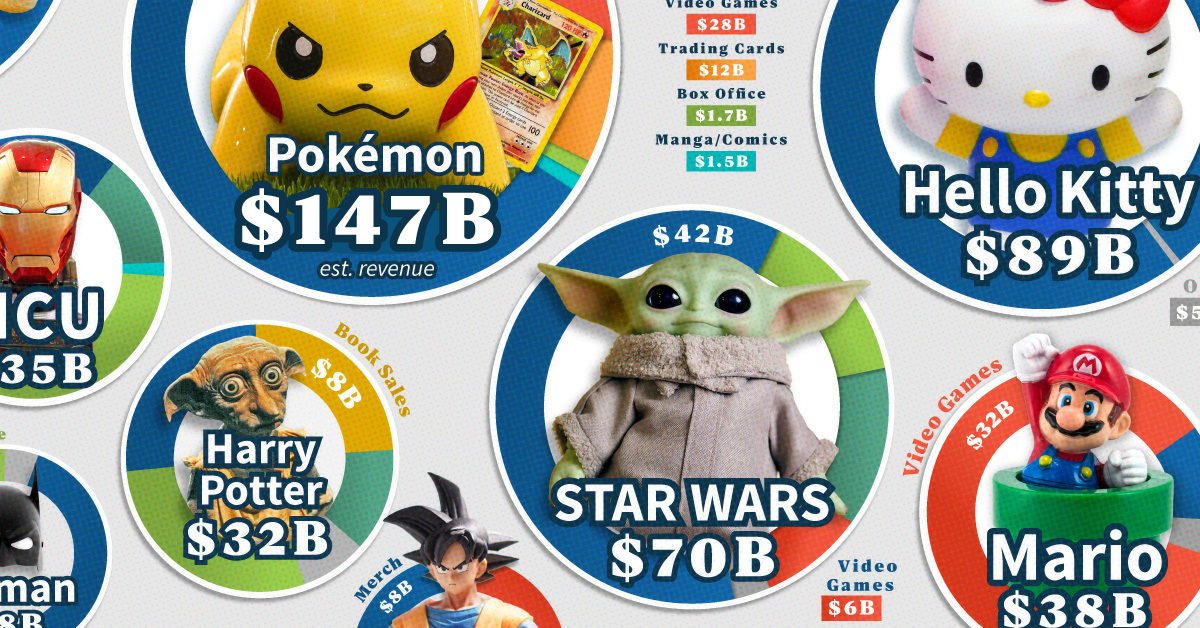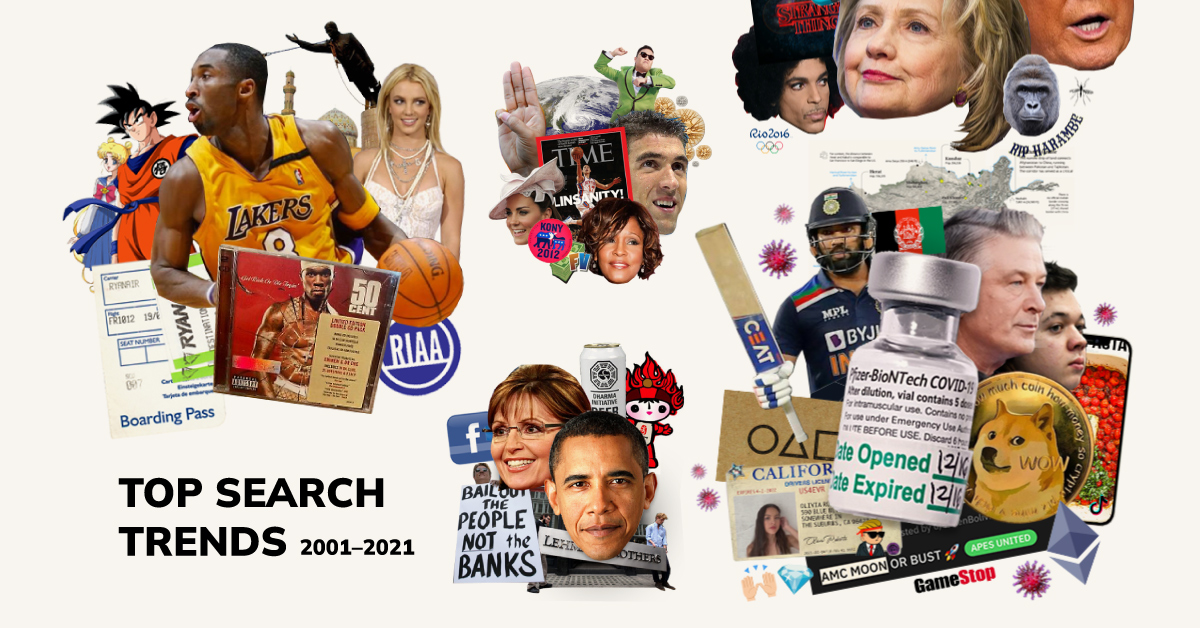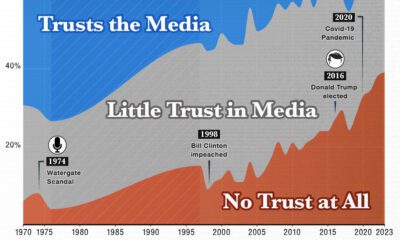Culture
20 Years of Top Trending Google Searches

20 Years of Top Trending Google Searches
For decades, Google search has been a go-to source for many when looking up directions, keeping up with the news, or seeking information on new and unfamiliar topics.
Today, Google processes about 3.5 billion searches per day. Because of its dominant market share, Google holds a vast archive of keyword searches that, when analyzed, provide an interesting glimpse into the key themes that have captured the world’s attention over the years.
This graphic, using data from Google Trends, goes back 20 years and highlights some of the top keyword searches since 2001.
Our editorial team dug through hundreds of top trending search terms from global and U.S. data and hand-selected their top picks, which are featured in the graphic above.
Trending vs. Volume
Before diving in, it’s worth emphasizing how top trending searches differ from popular searches, which are measured by sheer volume.
Trending searches are terms that have recently spiked in popularity. They focus on growth rather than total volume, and in this dataset, trending terms gauge year-over-year growth.
A good example is Donald Trump, who popped up in the news cycle during the 2016 presidential campaign. After the election, interest in Trump remained high. But his name doesn’t pop up on the Google trends list after 2017, since by that point, search volume for Trump had plateaued.
What are the most popular Google search terms, by volume? To be honest, they’re slightly less interesting than the top trending searches — YouTube is number one, followed by Facebook, then WhatsApp web.
The Globalization of Search Trends
The people and topics featured in Google’s top trends lists evolves as time goes on, reflecting broader adoption of the internet (and Google Search) around the world over time. Early themes are tied to mainstream U.S. pop culture and tech trends.
As time goes on, social media and smartphone adoption increase the granularity and volume of searches, resulting in top trends that are more participatory, diverse, and global in nature.
One final variable to keep in mind is that Google itself began to share more detailed search highlights with each passing year.
Two Decades of Google Searches: Macro Insights
Now that we’ve explained what trending searches actually measure, let’s dig into some of the key themes that have emerged over the last two decades of Google searches.
① People Love Sports
Over the last 20 years, sports have remained a continuous trend.
Every four years, the World Cup shows up as a top trending keyword across the globe. The Olympics also makes a regular appearance, along with Olympic athletes like Michael Phelps and McKayla Maroney.
Although the U.S. dominates the list, particularly when it comes to athletes, there’s still a good variety of international sports that go viral, especially as time goes on. In the last two years, cricket, rugby, and soccer have all made the top five trending lists.
② The Emergence of Celebrity 2.0
Over time, you can also see a transition from the conventional celebrity to celebrity 2.0, also known as the social media celebrity.
In the early 2000s, pop culture icons like Britney Spears, Eminem, and Jennifer Lopez flooded the trending searches, and traditional media forms like TV shows and Movies dominated the mass media categories.
But by 2011, YouTube stars like Rebecca Black started to make their way on the trending search lists. And in 2014, Meme emerged as a top trending category.
This transition nods to a larger shift in media, as digital has gradually overtaken traditional media as the dominant form of entertainment.
③ Natural Disasters are Top of Mind
Natural Disasters are a key trend throughout this data set as well.
Hurricanes are a particularly trendy word, showing up almost half the time—in eight of the 20 years. In 2005, Hurricane Katrina ranked second in the most searched category across the globe.
It continued to gain global attention—by 2006, Hurricane Katrina was still in the top five trending news searches.
Dig Deeper into Trending Google Searches
Our team enjoyed sifting through 20 years of Google data, and we hope you enjoyed this blast from the past too. If you’d like to dive deeper, you can explore Google’s full dataset here.
Happy searching.
Culture
The World’s Top Media Franchises by All-Time Revenue
From Pokémon to Hello Kitty, some media franchises are globally recognizable. How do media franchises compare in terms of all-time revenue?

Global Media Franchises by All-Time Revenue
This was originally posted on our Voronoi app. Download the app for free on iOS or Android and discover incredible data-driven charts from a variety of trusted sources.
From Pikachu to Hello Kitty, some media franchises become so big that their iconic characters are recognizable to nearly everyone in the world. But how exactly do these mega media franchises make their money, and how do they compare in terms of all-time revenue?
This graphic visualizes and ranks the world’s largest media franchises by their all-time revenue, showing the main revenue sources for each media franchise using data from Fandom.
Japan’s Media Franchises Reign
With more than half of the media franchises in this graphic originating from Japan, the Asian country dominates when it comes to modern popular media franchises.
The country has produced some of the biggest media franchises which span across mediums, whether it’s video games with Pokémon and Mario, or comics, animated series, and toys with franchises like Dragon Ball and Transformers.
| Media Franchise | Total Estimated Revenue | Merchandise Revenue | Video Games Revenue | Trading Cards Revenue | Box Office Revenue | Manga/Comics Revenue | Book Sales Revenue | Home Video Revenue | Other Revenue |
|---|---|---|---|---|---|---|---|---|---|
| Pokémon | $147.0B | $102.9B | $27.6B | $12.1B | $1.8B | $1.5B | - | $0.9B | - |
| Hello Kitty | $89.0B | $88.5B | - | - | - | $0.02B | - | - | - |
| Winnie the Pooh | $76.0B | $76.2B | - | - | $0.5B | - | - | - | - |
| Mickey Mouse & Friends | $74.0B | $73.4B | - | - | $0.5B | $0.0005B | - | - | - |
| Star Wars | $70.0B | $42.2B | $6.0B | - | $10.3B | - | $1.8B | $9.1B | $0.3B |
| Anpanman | $56.0B | $56.4B | - | - | $0.1B | - | - | - | $0.03B |
| Disney Princess | $46.0B | $46.3B | - | - | - | - | - | - | - |
| Jump Comics (Shōnen Jump) | $40.0B | - | $0.2B | - | - | $39.8B | - | - | - |
| Mario | $38.0B | $4.3B | $32.4B | - | $0.0B | $1.6B | - | - | - |
| Marvel Cinematic Universe (MCU) | $35.0B | $12.5B | - | - | $22.6B | $0.001B | - | - | - |
| Harry Potter | $32.0B | $12.3B | $1.6B | - | $9.9B | - | $7.7B | - | $1.1B |
| Transformers | $30.0B | $12.2B | - | - | $4.9B | - | - | - | $0.9B |
| Spider-Man | $29.0B | $15.9B | $1.7B | - | $7.2B | $1.1B | - | $2.2B | $1.4B |
| Batman | $28.0B | $21.3B | - | - | $6.1B | - | - | $1.2B | $0.3B |
| Dragon Ball | $27.0B | $7.7B | $6.2B | $1.0B | $0.8B | $9.2B | - | $2.1B | $0.05B |
| Gundam | $26.9B | $26.4B | - | - | - | $0.2B | - | - | $0.3B |
| Barbie* | $24.7B | $22.7B | - | - | $0.01B | - | - | $2.0B | - |
*Barbie’s revenue does not include revenue from the 2023 movie Barbie.
Even Japanese media franchises which have had less international exposure and revenue, like Anpanman and Jump Comics, have netted tens of billions in revenue mostly from their domestic popularity.
Besides Japan, Disney is the other dominant force when it comes to global media franchises, with all of the 10 largest franchises either hailing from Japan or owned by Disney.
Disney’s Major Media Acquisitions
Over the past two decades, Disney has built up a significant catalog of major media franchises through two key multi-billion dollar acquisitions.
Disney’s acquisitions of Marvel Entertainment for $4.4 billion in 2009 and Lucasfilm for $4.05 billion in 2012 added massive media franchises to their portfolio like Star Wars, the Marvel Cinematic Universe, and Spider-Man.
While Sony bought the movie rights to Spider-Man for just $7 million from Marvel in 1999, Disney owns the rights to Spider-Man in all other forms, including merchandising, television, and comics.
Movies Make their Comeback for Media Franchises
This past decade has seen various popular media franchises take another stab at expanding into the medium of movies and TV shows, this time finding significant success.
Whether it’s animated movies like The Super Mario Bros. Movie or live-action adaptations like Barbie or Netflix’s series of Jump Comics properties like One Piece, these film forays have been successful in revenue terms and in expanding their franchise fanbases.
On top of this, companies like Nintendo are tapping into their franchises to expand beyond movies, with Mario now also the leading mascot for the Super Nintendo World theme park area which has locations at both Universal Studios Japan and Hollywood.
-

 Demographics7 days ago
Demographics7 days agoThe Countries That Have Become Sadder Since 2010
-

 Green2 weeks ago
Green2 weeks agoRanked: The Countries With the Most Air Pollution in 2023
-

 Green2 weeks ago
Green2 weeks agoRanking the Top 15 Countries by Carbon Tax Revenue
-

 Markets2 weeks ago
Markets2 weeks agoU.S. Debt Interest Payments Reach $1 Trillion
-

 Mining2 weeks ago
Mining2 weeks agoGold vs. S&P 500: Which Has Grown More Over Five Years?
-

 Energy2 weeks ago
Energy2 weeks agoThe World’s Biggest Nuclear Energy Producers
-

 Misc2 weeks ago
Misc2 weeks agoHow Hard Is It to Get Into an Ivy League School?
-

 Debt2 weeks ago
Debt2 weeks agoHow Debt-to-GDP Ratios Have Changed Since 2000















